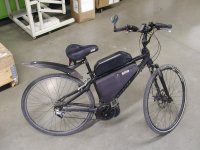Hi I know that all the above don't go together but let me explain.
I want to make an e-tourer on a GT hardtail, cromoly frame.
I want to be able to travel 100 km at a time, at 50 km speed, with continuous pedal contribution of 130-150 Watts from me constantly.
I was thinking C-lyte HS3540 or 3548 but are there better options nowadays? Something lighter? I am thinking 1-2 kw hub motor.
Also what controller do you propose.
(Would love Bluetooth connectivity)
And what battery? Thinking 52V 14Ah.
MTB will be transformed with road tyres (26X1.3) and possibly road bars for more aerodynamic position.
Thanks
Sent from my Mi MIX 2 using Tapatalk
I want to make an e-tourer on a GT hardtail, cromoly frame.
I want to be able to travel 100 km at a time, at 50 km speed, with continuous pedal contribution of 130-150 Watts from me constantly.
I was thinking C-lyte HS3540 or 3548 but are there better options nowadays? Something lighter? I am thinking 1-2 kw hub motor.
Also what controller do you propose.
(Would love Bluetooth connectivity)
And what battery? Thinking 52V 14Ah.
MTB will be transformed with road tyres (26X1.3) and possibly road bars for more aerodynamic position.
Thanks
Sent from my Mi MIX 2 using Tapatalk



